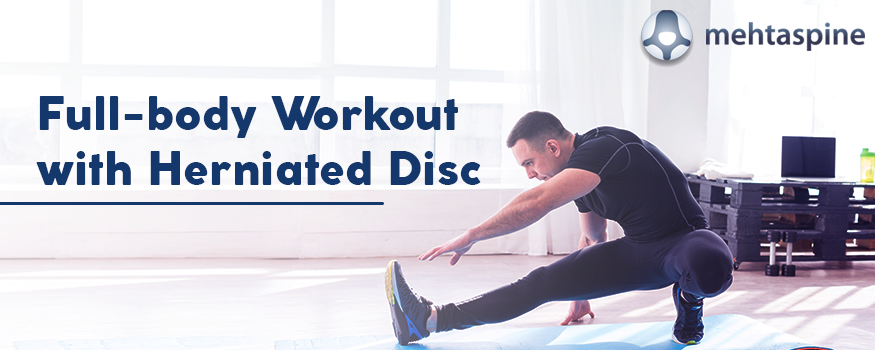Full body workout with Herniated Disc
Spinal discs act as cushions for our vertebrae, facilitating optimal weight distribution, smooth movements, and impact flexibility in the spine. Disc herniation occurs when the soft jelly-like substance inside the discs protrudes through the outer layer, putting pressure on nearby nerves. This can result in pain, numbness, tingling sensations, and weakness.
Herniated Disc – A Source of Significant Pain and Discomfort:
“Symptoms of herniated discs can vary from person to person, but this problem can significantly impact a patient’s quality of life,” says UK spine surgery specialist Mr. Jwalant S. Mehta. Lower back pain, buttocks pain, leg pain (sciatica), muscle weakness, radiating pain, irritating numbness, and tingling sensations are common debilitating symptoms for patients suffering from herniated discs. In this blog, let’s explore five little-known tips to help patients manage pain and alleviate these symptoms.
Herniated Disc: 5 Lesser-Known Tips for Pain Relief
Heat and Cold Therapy: Utilize heat therapy to increase blood flow, loosen muscle tightness, and improve elasticity. Apply a heat pack or warm compress before stretching. Additionally, use cold therapy after exercise and try to reduce local temperatures to provide an anti-inflammatory effect. This can help alleviate muscle tension and pain associated with a herniated disc.
Maintain Correct Posture: Avoid activities that exert additional pressure on the spine, such as wearing high heels, prolonged sitting or standing, and repetitive bending. Consulting a specialist for guidance on maintaining proper posture throughout the day is crucial to prevent worsening pain associated with a herniated disc.
Weight Management: Excessive weight, especially in the lower abdomen, can stress the lower back, particularly when combined with weak core strength. Ensure optimal weight through a balance of physical activity and diet control to prevent unnecessary strain on the spine.
Moderate Physical Activity: Surprisingly, moderate physical activity can help relieve pain and promote healing in herniated disc cases. You engage in activities like walking, cycling, and elliptical training, which releases endorphins, reduces pain perception, and improves blood circulation. Avoid heavy and intense exercises to minimize the risk of complications.
Choose the Right Sleep Positions: Since we spend about 8 hours sleeping, choosing sleep positions is crucial for managing pain associated with a herniated disc. Use a pillow below the knees when sleeping on your back, or place a cushion between the knees on your side. These positions can straighten the spine and balance the hips, reducing excessive pressure on the spine. Consult with a professional to find the optimal sleeping position based on the specific location of the herniated disc.
In addition to the above, myofascial release to reduce pain, the McKenzie Method to shift sciatica pain, and OTC medications are other effective methods to relieve pain in herniated discs. However, in a few cases, the patient may need a much more comprehensive approach to treating the pain in herniated disc cases, some even leading to surgery. So, if all the above methods fail to provide adequate relief, it is essential to consult a qualified spine specialist to reduce pain and ensure the proper treatment.


